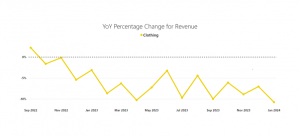By Ellie-Rose Davies, Content Executive, IMRG
We have liaised with our technology partner community to provide you with top insights on online retail fashion performance and strategies to boost growth in 2024. In reading this blog, you will be able to benchmark your performance and consider new customer engagement opportunities.
Fashion Findings by IMRG:
After an entire year of Year-on-Year (YoY) declines reported for the clothing category in 2023, fashion retailers were left hoping for a promising start to the new year, eagerly anticipating for IMRG to reveal their Online Retail Index results for January.
Unfortunately, we are the bearers of bad news – Out of 16 months of declines, January reported the steepest fall for clothing retailers, at -10.8% YoY. This drop is against the -3.1% decline reported in January 2023, revealing negative-against-negative growth for the fashion sector.

Noticeably, the worst performing subcategory of clothing has been accessories, which in January saw its steepest decline since February 2020, at -26.4% YoY. Menswear is also having a hard time, declining by -16.7% YoY in January. The subcategories that are seeing better performance are womenswear and footwear, however not one single subcategory reported positive growth this month.
The average conversion rate (total sessions) for clothing retailers has dropped from 3.29 in Jan 2023 to 2.74 in Jan 2024, and the average basket value has increased from just over £67 to just under £86. These results stem from a variety of factors, from increased pricing to shifts in customer behaviour, e.g., buying more items but less frequently to save on shipping costs, and making more considered purchases due to inflationary pressures.
So, what can fashion retailers do to achieve growth?
Engage cost-conscious shoppers:
The results have shown that customers have become more cost-conscious, and subsequently less likely to spend with fashion retailers. Because of this, it has become important to tune into customer psychology and consider methods that will engage hesitant shoppers.
Paul Dodd, Co-Founder and Chief Innovation Officer at Huboo, reflects on changes in customer behaviour, sharing, ‘I expect to see fashion brands adapting to meet the needs of staycationers and people on limited budgets rather than just going after jetsetters this summer. 2024 will be another year in which many people – particularly younger fashionistas – must keep tight control over the purse strings and may have to forgo big summer holidays.’
‘Expect to see traditional holiday gear reimagined for festivals, camping, glamping and the many other delights of the great British summer,’ says Paul. Also, Paul describes how ‘Many fashion brands have made huge strides in recent years to improve the sustainability of their products.’
He continues, ‘In the face of ever more discerning consumers in 2024, it’s important that this commitment extends right the way through to fulfilment – from the packaging used to ship new items, to the delivery partners selected.’
Further exploring the value of customer engagement strategies is A.J Ghergich, VP Consulting Services at Botify. He says, ‘With Google prioritising visual search and browsable experiences, nailing your Google Merchant Center listings is key to outshining the competition.’
A.J provides top tips to accelerate growth, starting with what he calls ‘Visual Vogue.’ To achieve this, retailers should ‘elevate product displays with high-resolution images as detailed visuals capture attention, driving engagement.’ He also champions ‘Title Glamour,’ where retailers can ‘craft keyword-rich product titles that reflect their brand’s style.’
A couple of other tips from A.J. is to prioritise ‘Navigation Excellence’ and ‘Detail Drama’, using ‘intuitive categories for browsing, mirroring the thoughtful organisation of a boutique,’ and offering ‘exhaustive product details (size, colour, material) to mimic a virtual fitting room.’
Thinking of the browsing experience, retailers can also highlight seasonal lines in their menus and categories, such as with staycation edits, to boost traffic.
Nicole Morton, Cross-Border Solutions Manager at Avalara describes how more cost-conscious shoppers has resulted in the ‘growing popularity of recommerce (sales of used of “pre-loved items), which is on track to grow three times faster than traditional retail through to 2030.’
Subsequently, ‘Retailers should consider entering this space to accelerate growth,’ says Nicole. ‘However, if you create a resale site, you may turn yourself into a marketplace facilitator and could end up liable for collecting and remitting the tax due on sales made through the site.’ Thus, retailers should be ‘compliant when exploring new channels.’
Be tactful with pricing and discounting:
When times are difficult and when panic mode sets in, it is quite easy to act without strategy in hope for a miracle. Often retailers resort to heavy, unsustainable, discounting and implementing pricing changes without a strong steer of the result.

Interestingly, Sam Panzer, Director of Industry Strategy at Talon.One advises for fashion retailers to ‘run fewer discounts.’ He says, ‘That might seem at odds with Talon.One’s business that focusses on promotions and loyalty, but what we hear time and again from many retailers is how poorly run promotions damage margins and condition consumers to expect discounts.’
‘If that sounds familiar,’ says Sam, ‘we recommend setting a strategy of experimentation to see how you can turn blanket discounts to non-price promotions (bundling, multi-buys, gifts with purchase, services, etc) and protect AOV & margin when you do run selective price promotions.’
To run engaging offers, Sam explains the value of ‘building promotions with any item, SKU or inventory data, personalising items to the consumer based on customer data, and saving the best offers for high-intent or high-value customers.’
Dan Bond, VP of Marketing at RevLifter urges retailers to ‘experiment with value exchange points. Classic examples include offering a 10% discount in exchange for an email signup or first purchase – What would happen if you offered more or less? – Alternatively, consider providing free delivery as an incentive.’
He says, ‘Remember to assess the impact throughout the entire funnel. It’s not just about immediate conversion and abandonment rates but also about the effect on repeat purchases, customer loyalty, and customer lifetime value (LTV). Offering more value upfront may lead to greater long-term benefits. Develop hypotheses and conduct tests over time with a valid sample size.’
CEO & Co-Founder of Prisync, Burc Tanir, explores the value of benefit-led engagement methods, stating, ‘For clothing retailers seeking growth in 2024 during periods of weak demand, I highly recommend prioritising data-driven strategies and optimising pricing models (the number of price-sensitive consumers is increasing every year).’
Ultimately, ‘Since there are too many options online, consumers are seeking worthy and personal reasons to purchase from your shop,’ says Burc.
Prioritise retention and loyalty (post-purchase):
Methods to captivate customers are often focussed on the earlier stages of the customer purchasing funnel, but there are often fewer hooks during the post-purchase stage, which can be a lost opportunity for loyalty and repeat purchases.
Angus Knights, Head of Product Success at parcelLab says, ‘To stand out in a challenging online fashion market, clothing retailers should prioritise customer experience and post-purchase engagement, ensuring the customer’s satisfaction is the key focus.’
He exclaims, ‘Retailers should offer seamless, transparent interactions from browsing to delivery, providing personalised shipping notifications and returns processes to enhance customer loyalty. They might also embrace sustainability and inclusivity as cornerstones of their brand ethos, by showcasing eco-friendly practices and diverse fashion lines that reflect consumer values.’
Delving into the value of prioritising the post-purchase experience is Sean Sherwin Smith, Product Director Post-Purchase at nShift. He says ‘One of the most common reasons cited for cart abandonment is ‘lack of delivery choices’ but, by offering and clearly badging a range of delivery options, ecommerce companies can increase conversions by 20%. Beyond this, some 78% of online shoppers will change brands or retailers, if they don’t receive regular updates on the status of their order so having a digitised process can make a real difference.’
The same goes for returns, where Sean provides the example of QUIZ, who ‘provide notifications to each customer on precisely where their return is in the process and ensures QUIZ has visibility of every step of the delivery and returns process.’
Gavin Murphy, CMO at Scurri says, ‘Given that fashion retailers are facing squeezed demand, with consumers taking longer to validate their purchasing decisions or rationalising what fashion purchases are necessary or a nice to have, retailers need to consider how and when they can re-engage the shopper, teeing them up to consider their next purchase.’
He continues, ‘Post-purchase customer engagement, which takes place after the consumer has checked out, is a key platform for this – and is often when the shopper is most likely to interact with brand-led communications, providing a valuable and effective channel to up- or cross-sell to the consumer.’
To keep up to date with fashion performance, check out IMRG’s Digital Dashboard which provides weekly insights into category performance across a wide range of metrics.
Want to read more? Here are some other IMRG blogs that cover a range of ecommerce topics:
Future Gazing: Great Expectations for Online Retail in 2024 – IMRG
Unboxing The Trends: Christmas & Boxing Day Ecommerce Insights Revealed (2023) – IMRG
Black Friday 2023: The Key Findings – IMRG
Published 12/02/2024


